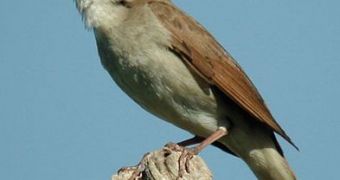1.Birds really have their "dialects", just like human languages. When researchers played to the birds from one population the recorded song of birds from other population, they remained indifferent to the voice of the same species if coming from another area, even if for the human ear, the songs of both populations sounded similarly.
2.Many studies made in humans revealed that what we learn during the day is imprinted in our brain during sleep. Persons devoid of sleep have impaired learning. But the same fact happens with birds: a research made on finches revealed that birds record in a brain nucleus the song heard during the day, which is then processed and imprinted during sleep.
3.A research made on zebra finches revealed that in the song birds, the right side of their brain discriminated better the sounds, even if both sides of the brain were activated.
4.Birds' songs are not meant to delight our ear: their songs either defend a territory by warning off other males or attract females.
5.Like humans, songbirds are among the only animals which can learn new and complex vocal skills. Even mastering grammar-like patterns could be part of their cognitive repertoire.
6.Budgerigars are probably the most known parrots commonly kept as pets and which easily reproduce in captivity. This small Australian bird produces highly variable contact calls. Male budgerigars making a couple with more similar-sounding females help more the nesting females.
Male budgerigars also spontaneously imitate the calls of females during the mating time. Females also proved to be more attracted by males who learned to produce calls similar to theirs. Even more, the new research showed that they prefer males that sound like them at their first meeting, before any imitation occurred.
7.There is an opposite connection between birds' vocalizations and plumage. Think of the peacock, with its splendid plumage and putting out the most horrible bird calls and the nightingale, with its dull plumage.
There is a lot of energy spent in plumage or singing; a bird male cannot combine both strategies to advertise his quality genes.
8.A 2007 research showed that male birds consuming invertebrates from soils contaminated with estrogen-mimicking chemicals had more complex songs, turning them into the preferred of the females, but this comes at the price of a decreased immunity. This was the case of European starlings (Sturnus vulgaris) feeding close to a sewage treatment station, in the south-west UK, and earthworms that made their base diet.
Males consuming earthworms with a complete array of estrogen-mimicking chemicals sang longer, more often and more complex, fact that boosted their sexual success. The effect was connected to the high vocal center (HVC), a brain nucleus related to male song complexity, which appeared to have a larger size in the contaminated birds.
Estrogen, even if a female sex hormone, appeared to induce masculinization in the songbird brain due to the high number of estrogen receptors in HVC.
The same hormone-mimicking chemicals, dumped into the water, are the cause of a boom in cases of hermaphroditism in fish and frogs.
9.In bird species in which the female represents the active sex, she is the one to sing. Traveling during this period into the emu land, you will be amazed by hearing some very low waves of sounds. Literally, the air is filled with this noise.
To the surprise of the first biologists who studied the emu, the vibrations like sounds are produced by females with air sacks from their chests! These sounds are called "drumming" or "booming".
The deep rumbling sound, with its very low frequency, has properties similar to the infrasounds emitted by elephants for long distance communication, and that's why they travel far away many miles. During the courtship, both genders start strutting and circling; ruffling out their feathers and cocking their heads in a shy posture.
In many species, like African shrikes, the two genders make duets.
10.Scientists have linked high testosterone levels in male birds to high level of carotenoids, the pigments that give the bright red/yellow/orange color on birds' feathers, beaks, and legs. More testosterone has been connected to more elaborate singing.

 14 DAY TRIAL //
14 DAY TRIAL //